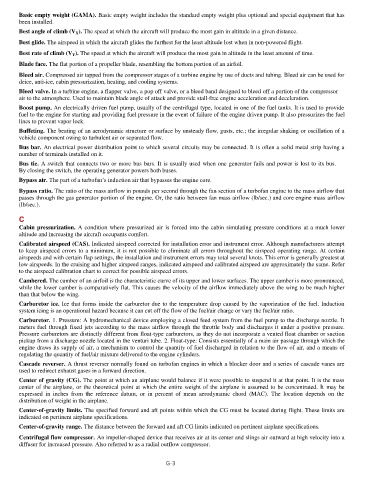Page 375 - Airplane Flying Handbook
P. 375
Basic empty weight (GAMA). Basic empty weight includes the standard empty weight plus optional and special equipment that has
been installed.
Best angle of climb (V X ). The speed at which the aircraft will produce the most gain in altitude in a given distance.
Best glide. The airspeed in which the aircraft glides the furthest for the least altitude lost when in non-powered flight.
Best rate of climb (V Y ). The speed at which the aircraft will produce the most gain in altitude in the least amount of time.
Blade face. The flat portion of a propeller blade, resembling the bottom portion of an airfoil.
Bleed air. Compressed air tapped from the compressor stages of a turbine engine by use of ducts and tubing. Bleed air can be used for
deice, anti-ice, cabin pressurization, heating, and cooling systems.
Bleed valve. In a turbine engine, a flapper valve, a pop off valve, or a bleed band designed to bleed off a portion of the compressor
air to the atmosphere. Used to maintain blade angle of attack and provide stall-free engine acceleration and deceleration.
Boost pump. An electrically driven fuel pump, usually of the centrifugal type, located in one of the fuel tanks. It is used to provide
fuel to the engine for starting and providing fuel pressure in the event of failure of the engine driven pump. It also pressurizes the fuel
lines to prevent vapor lock.
Buffeting. The beating of an aerodynamic structure or surface by unsteady flow, gusts, etc.; the irregular shaking or oscillation of a
vehicle component owing to turbulent air or separated flow.
Bus bar. An electrical power distribution point to which several circuits may be connected. It is often a solid metal strip having a
number of terminals installed on it.
Bus tie. A switch that connects two or more bus bars. It is usually used when one generator fails and power is lost to its bus.
By closing the switch, the operating generator powers both buses.
Bypass air. The part of a turbofan’s induction air that bypasses the engine core.
Bypass ratio. The ratio of the mass airflow in pounds per second through the fan section of a turbofan engine to the mass airflow that
passes through the gas generator portion of the engine. Or, the ratio between fan mass airflow (lb/sec.) and core engine mass airflow
(lb/sec.).
C
Cabin pressurization. A condition where pressurized air is forced into the cabin simulating pressure conditions at a much lower
altitude and increasing the aircraft occupants comfort.
Calibrated airspeed (CAS). Indicated airspeed corrected for installation error and instrument error. Although manufacturers attempt
to keep airspeed errors to a minimum, it is not possible to eliminate all errors throughout the airspeed operating range. At certain
airspeeds and with certain flap settings, the installation and instrument errors may total several knots. This error is generally greatest at
low airspeeds. In the cruising and higher airspeed ranges, indicated airspeed and calibrated airspeed are approximately the same. Refer
to the airspeed calibration chart to correct for possible airspeed errors.
airfoil is the characteristic curve of its upper and lower surfaces. The upper camber is more pronounced,
Cambered. The camber of an
while the lower camber is comparatively flat. This causes the velocity of the airflow immediately above the wing to be much higher
than that below the wing.
Carburetor ice. Ice that forms inside the carburetor due to the temperature drop caused by the vaporization of the fuel. Induction
system icing is an operational hazard because it can cut off the flow of the fuel/air charge or vary the fuel/air ratio.
Carburetor. 1.
Pressure: A hydromechanical device employing a closed feed system from the fuel pump to the discharge nozzle. It
meters fuel through fixed jets according to the mass airflow through the throttle body and discharges it under a positive pressure.
Pressure carburetors are distinctly different from float-type carburetors, as they do not incorporate a vented float chamber or suction
pickup from a discharge nozzle located in the venturi tube. 2. Float-type: Consists essentially of a main air passage through which the
engine draws its supply of air, a mechanism to control the quantity of fuel discharged in relation to the flow of air, and a means of
regulating the quantity of fuel/air mixture delivered to the engine cylinders.
Cascade reverser. A thrust reverser normally found on turbofan engines in which a blocker door and a series of cascade vanes are
used to redirect exhaust gases in a forward direction.
Center of
gravity (CG). The point at which an airplane would balance if it were possible to suspend it at that point. It is the mass
center of
the airplane, or the theoretical point at which the entire weight of the airplane is assumed to be concentrated. It may be
inches from the reference datum, or in percent of mean aerodynamic chord (MAC). The location depends on the
expressed in
weight in the airplane.
distribution of
Center-of-gravity limits. The specified forward and aft points within which the CG must be located during flight. These limits are
indicated on pertinent airplane specifications.
Center-of-gravity range. The distance between the forward and aft CG limits indicated on pertinent airplane specifications.
Centrifugal flow compressor. An impeller-shaped device that receives air at its center and slings air outward at high velocity into a
diffuser for increased pressure. Also referred to as a radial outflow compressor.
G-3

